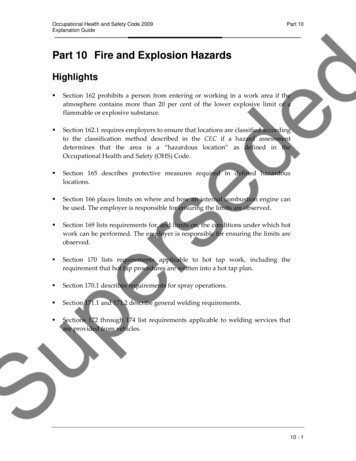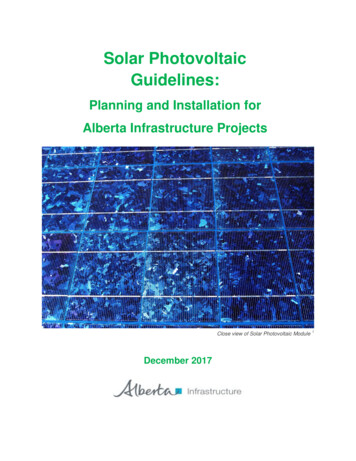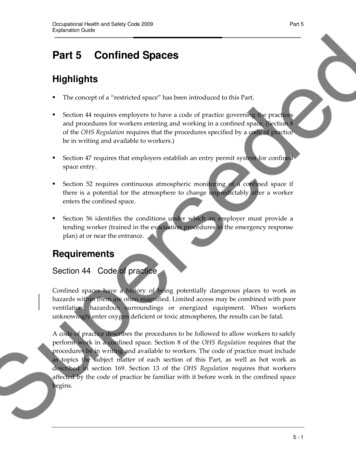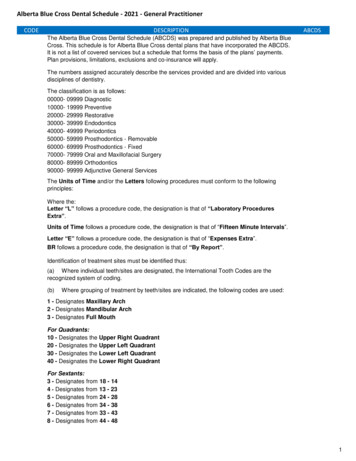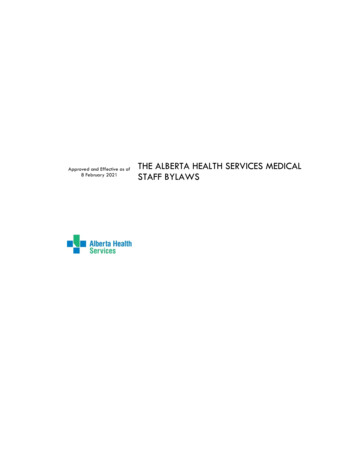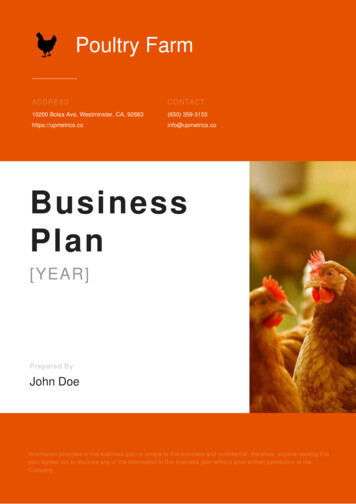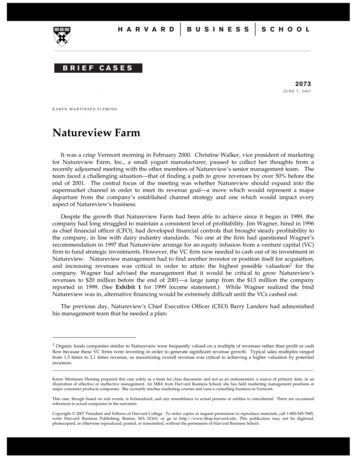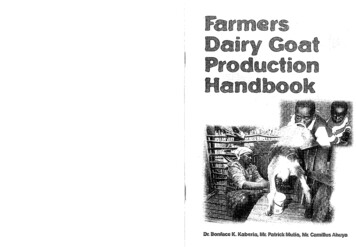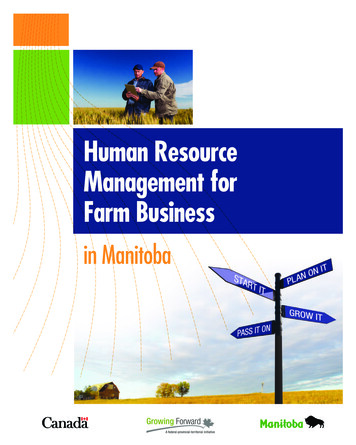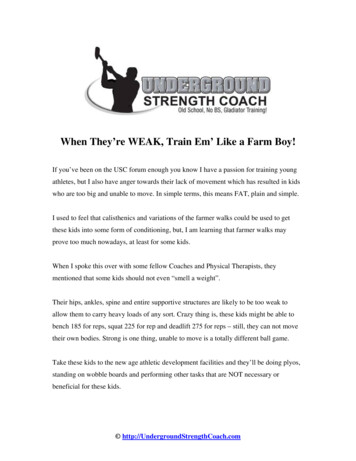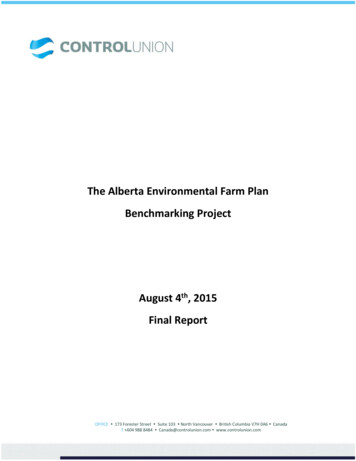
Transcription
The Alberta Environmental Farm PlanBenchmarking ProjectAugust 4th, 2015Final ReportOFFICE 173 Forester Street Suite 103 North Vancouver British Columbia V7H 0A6 CanadaT 604 988 8484 Canada@controlunion.com www.controlunion.com
Table of Contents1. The Alberta Farm Plan Benchmarking Project . 12. Methodology . 23. The Alberta Environmental Farm Plan . 44. The Sustainability Standards / Initiatives. 5i.) The Sustainable Agriculture Initiative (SAI) - Farmer Self-Assessment (2.0) . 5ii.) Unilever’s Sustainable Agriculture Code . 8iii.) International Sustainability and Carbon Certification (ISCC) . 115. Conclusion . 15Appendix 1 . 16OFFICE 173 Forester Street Suite 103 North Vancouver British Columbia V7H 0A6 CanadaT 604 988 8484 Canada@controlunion.com www.controlunion.com
1. The Alberta Farm Plan Benchmarking ProjectControl Union, a global leader in sustainable certifications, was commissioned by the AgriculturalResearch and Extension Council of Alberta (ARECA) to benchmark their Alberta Environmental Farm Planagainst three widely used and globally recognized sustainability standards or initiatives. The initiativeswere the Sustainable Agricultural Initiative Farmer Self-Assessment (SAI FSA v.2.0), InternationalSustainability & Carbon Certification (ISCC) and the Unilever’s Sustainable Agriculture Code (ULSAC). Inrecent years, sustainability initiatives and certifications have become a growing procurement trend asmajor corporations have recognized that food and water availability will become scarce as the globalpopulation grows and the emerging markets obtain higher standards of living and increase their demandfor meat, dairy and other high input animal proteins commoditiesThe sustainability norms of ISCC, SAI Self-assessment and Unilever SAC all broadly share conceptualelements within the areas of environmental, social, economic and ethical criteria. Some of these criteriaare generically outlined below: Page1Environmental Criteria soils stewardship and conservation, efficient and judicious use ofagrochemicals, nutrient management, biodiversity enhancement and protection, waste, waterincluding assessment of water extraction vs water replenishment. Additional criteria are carbonemissions, protection of peat lands and areas of high carbon value such as native forests andgrass lands Social criteria are composed of Human rights, worker conditions, social protection,employment relations, human development and social dialogue. Management criteria include economic viability, sustainable management, & supply chainresponsibilities. Ethics criteria include no forced or child labour, anti-corruption and compliance with legislation.OFFICE 173 Forester Street Suite 103 North Vancouver British Columbia V7H 0A6 CanadaT 604 988 8484 Canada@controlunion.com www.controlunion.com
2. MethodologyControl Union assessed the Alberta Environmental Farm Plan (AEFP) against the Sustainable AgricultureInitiative (SAI) Farm Self-Assessment 2.0., Unilever’s Sustainable Agricultural Code (ULSAC), and theInternational Sustainability and Carbon Certification - PLUS (ISCC PLUS) standards. The overall objectiveof this project was to make a comparative assessment of the Alberta Environmental Farm Plan againstthese standards in order to identify matching requirements and to highlight areas that are fully, partiallyor entirely omitted from the Alberta Environmental Farm Plan.This benchmark utilized methodology which is consistent with the methods used by Control Union andother certification groups when assessing other agricultural sustainability standards. Each criteria in theAlberta Environmental Farm Plan was compared with each standard using one of the following scoringrankings:0 AEFP does not cover this issue1 AEFP partially covers this issue2 AEFP equivalent to standard in comparison3 AEFP exceeds standard in comparisonScores are calculated for both compliance and for performance. The score for compliance indicateswhether the AEFP has met the minimum compliance criteria. The performance score may indicates ascore of 3 where the AEFP criteria exceed the minimum compliance criteria. Because compliance is abinary system exceeding the minimum cannot increase a score. When the EFP exceeds the minimumcompliance this is can only be reflected in the performance score.Page2The ‘maps’ of green, amber, red are used to highlight the gaps or areas that should be strengthened.OFFICE 173 Forester Street Suite 103 North Vancouver British Columbia V7H 0A6 CanadaT 604 988 8484 Canada@controlunion.com www.controlunion.com
Below is an example of how this benchmark was structured. The ULSAC’s agrochemical criteria requiremore detailed records for chemical applications in comparison to a much more limited recordrequirement in the AEFP criteria. The example clearly details the criteria of both standards and outlineswhere they are the same and where differences are noted. A score is given based upon the evidence.Standard RequirementAEFP PracticesCommentScore3. Agrochemical applicationrecordThe AEFP covers theAgrochemical applicationrecord on The AEFP request no coverdata of:a) Product nameb) Active ingredient/fertiliser typec) Crop area applied to(including location identifier)f) Operator nameg) Re-entry period (CPPsonly)h) Pre-harvest interval(CPPs only)A score of 1was assigned.a) Product nameb) Active ingredient/fertiliser typec) Crop area applied to(including location identifier)d) Ratee) Application datef) Operator nameg) Re-entry period (CPPsonly)h) Pre-harvest interval (CPPsonly) Stage of crop and pestdevelopmentMappingofpestdistributionanddensity within fieldDay and time of daywhen sprayingWeather conditionsEquipment settingsRates appliedPage3*Unilever’s SAC – example of how criteria match up on spreadsheet data.OFFICE 173 Forester Street Suite 103 North Vancouver British Columbia V7H 0A6 CanadaT 604 988 8484 Canada@controlunion.com www.controlunion.com
3. The Alberta Environmental Farm PlanThe AEFP was developed as a tool to assess individual farm risks and to aid in the development ofindividualized farm plans in order to reduce or control identified environmental risks. Every step in theprocess is entirely voluntary. The format of the AEFP is that of a work book which describes potentialrisks and ranks their severity using colour codes. The AEFP provides a clear and comprehensive set ofguidelines for the risk assessment of potential environmental contaminants. AEFP participants areasked to develop their plan and address all identified medium and severe risks i.e. red and yellow.Technicians are assigned to assist the producer with their EFP. The technician signs off on the actionplan developed by the producer. These technicians facilitate the understanding of the AEFP anddetermine if the identified risks are being adequately addressed. In some circumstances the EFP is usedas a prerequisite for government subsidies provided for infrastructure expenditures.The AEFP recommends that frequent reviews occur. The action steps in the Farm Plan should beimplemented continuously from one year to the next according to the priorities established by theproducer. There is no requirement for the producer to annually review their Farm Plan in order toevaluate progress.Experience shows that once the plans are implemented and payments were received, very few annualreviews occurred and no further continuous improvements were documented. This lack of annualreviews represents a significant omission relative to the three standards, ie ULSAC, ISCC and SAI.AEFP -Benchmark ResultSince there is no enforcement, the AEFP in its current form is of very limited use as a complianceassessment. For the purpose of this benchmark, the criteria are not considered as optional, when theAEFP states that all risk mitigation is at the option of the farmer / owner. They are scored relative to acolour code or risk severity.OFFICE 173 Forester Street Suite 103 North Vancouver British Columbia V7H 0A6 CanadaT 604 988 8484 Canada@controlunion.com www.controlunion.comPage4The strength of the AEFP is in the identification and documentation of agrochemical usage and controlto reduce pollution of strengthen management of water and soil resources. Other areas covered in thebenchmarked sustainability programs are omitted in the AEFP. These include the aforementionedcontinuous improvements, efficient water use, biodiversity, social and human capital, economicviability, value chain and ethical criteria. Another weakness of the AEFP is that the compliance is notcharacterized. It is externalized by using a technician to verify and as a result the limits of acceptable,unacceptable and prohibited criteria are not clearly defined. Fundamentally the AEFP was not designedas a compliance document and so this created the necessity for assumptions in the benchmarkingprocess.
4. The Sustainability Standards / Initiativesi.) The Sustainable Agriculture Initiative (SAI) - Farmer Self-Assessment (2.0)SAI is a multi-stakeholder initiative created in 2002 by its founding members Nestle,Unilever and Danone. The stakeholders recognized that the population is growingand is predicted to grow from 6.7 Billion (2009) to 9.7 Billion by 2050. Thepredicted population growth when coupled with the economic growth and thegrowing global demand for meat, dairy, fruit and vegetables means that the world’sfood production will need to double by 2050 in order to meet the growing global demand for milk, dairyand fresh vegetables. Additionally, water shortages are common in many countries and global warmingis causing weather patterns to shift.SAI allows for farmers to self-assess their own sustainable practices.The SAI Self-assessment is broken down into sections called Farming System, People, Planet and Profit.-“Farming System”. It is in this section entitled "sustainable farming systems" that the SAI Platform listswhat it considers to be the main elements of sustainable farming. These include section providesgeneral guidance on management practices which protect the natural environment while also protectingthe crop. Principles include the selection of crop varieties which are suitable for the soil, climate, andenhanced resistance to pests and disease. Agrochemical management which is designed to protect thepeople and the environment through comprehensive management practices at all times. Use ofpesticides according to the principles of integrated pest management (IPM), knowing the primary pestlife cycles, using pesticides in response to predetermined population levels. Soil managementrequirements are specified. This requires the monitoring of the soil nutrients, building soil conditionsand protection against soil erosion, nutrient leaching and emissions of greenhouse gases into theenvironment. Efficient water use to minimize unnecessary waste of a precious commodity, protectionof rare and endangered species and enhancement of biodiversity. Waste streams are included as theyare integral to a holistic management program controlling environmental impacts.Page5-“People”. Through the sharing of knowledge, people can make meaningful difference if given theopportunity. Therefore enhancing the health and safety of workers through training is important.Management systems for the storage of chemicals in a safe and secure way, providing clear legiblesafety signage, the protection of workers during application/re-entry, and adequate safety equipment,all reduce down potential risks as well as offer knowledge on safe practices. Finally, this section alsocovers the ethical treatment of employees against exploitation and discrimination.OFFICE 173 Forester Street Suite 103 North Vancouver British Columbia V7H 0A6 CanadaT 604 988 8484 Canada@controlunion.com www.controlunion.com
-The “planet” section focuses on environment. For example biodiversity can add value to the farmsystem by providing natural predators which can reduce, control or eliminate crop “pests”. Encouragingbiodiversity though riparian zones as well as farming practices that reduce down the harmful effect onnatural predators are encouraged.-Finally the “profit” section focuses on economic issues. The importance of a sustainable income orsustainable livelihood is often overlooked. Farmers, farm workers and farm corporations requireadequate cash flow to maintain themselves, and invest in equipment and other capital expenditures.This investment is required to improve the productivity of the soil, water and other resources.Maintaining livelihoods, capital improvements and other investments in personnel adds to the efficiencyof the enterprise and thereby leads to increased profitability.SAI- AEFP Benchmark Result:Page6The AEFP benchmark with the SAI has an overall correlation ranked as 36%. The broad focus of the SAIFSA v.2.0 is reflected in the description above. The weak benchmark score reflects the omission of manycriteria in the AEFP such as financial stability, health and safety, community, market access, labourconditions and Green House Gas emissions (GHG). Areas of strong correlation with SAI areagrochemicals, water management, nutrient management, crop protection and soil management. Thechart below provides additional detail.OFFICE 173 Forester Street Suite 103 North Vancouver British Columbia V7H 0A6 CanadaT 604 988 8484 Canada@controlunion.com www.controlunion.com
AEFP summary Scoring sheetSAI PLATFORM FARMER SELF ASSESMENT 2.0AEFP StandardEconomic sustainability22%Legal Compliance17%Financial Stability0%Farm Management70%Market Access0%Farming system76%50%PlantingSoil Management100%79%Nutrient ManagementCrop Protection59%Agro-chemicals94%Environmental sustainability48%Waste Management100%67%Water ManagementBiodiversity20%Air0%Greenhouse Gas Emissions50%Social sustainability0%Labor Conditions0%Health & safety0%Local Community0%35%Total compliance to SAI100% or above 0 / 100%0%Page7The weak scores of the benchmark against the SAI FSA v2.0 reflect that whole sections of criteria areomitted from the AEFP. These include economic sustainability, financial stability, and all of the socialethical sustainability criteria. When the AEFP is only scored against common criteria the score is 64%(see Appendix 1).OFFICE 173 Forester Street Suite 103 North Vancouver British Columbia V7H 0A6 CanadaT 604 988 8484 Canada@controlunion.com www.controlunion.com
ii.) Unilever’s Sustainable Agriculture CodeUnilever’s Sustainable Agriculture Code is the most formalized of various corporateinitiatives being used around the globe. The intention of the Unilever SAC is to achievea 100% sustainably sourced supply chain by 2020. The program is a self-assessmentwith farmers and suppliers being held accountable for the accuracy of their own assessments and spotcheck audits by a 3rd party to provide an objective oversight. The SAC further divides the general criteriaoutlined above into 11 chapters. The criteria are divided into prohibited, mandatory, must and shouldcategories. Farmers and suppliers must score 100% compliance in the prohibited and mandatorycategories and achieve a minimum overall 80% average compliance in the must categories. Many of thecriteria are common to SAI. However, the should criteria exceed the SAI requirements. The shouldcriteria are currently optional but may become more heavily weighted in the future.ULSAC- AEFP Benchmark Result:A fundamental principle and the first chapter of the ULSAC is continuous improvement. Therequirement is repeated again in each of the chapters. The overall score for the ULSAC benchmark is38% with the strongest correlation being in the agrochemical chapter. Criteria omitted in theagrochemical chapter includes the prohibition of untreated human sewage, the requirements for therisk assessment of agrochemical contamination to workers, neighbors and the environment, nozzlemaintenance and replacement, fertilizer spreader calibration, equipment maintenance records kept forminimum 2 years, dry and well ventilated chemical storage areas which are located such that risks in theevent of emergencies are minimized. The soil chapter requires a plan to phase out the use of nonrenewable resources such as peat and forest top soil. The water chapter requires records of waterquality, application records containing rates, dates, method, and location, calibration / maintenance,social and environmental impacts such as recharge of aquafer. The biodiversity chapter scoresdemonstrate extremely limited correlation with the ULSAC criteria. The ULSAC prohibits the huntingand collecting of rare or endangered species, the identification of species at risk and requires abiodiversity plan to provide enhancement or protection and monitoring of progress with the plan.Chapter 6 on energy includes greenhouse gas emissions calculation and records of use, an energymanagement plan and justification for burning of crop residues for field preparation. The waste chapterrequires records which identify and describe major waste streams, their management and justificationfor lack of implementation of the 3R’s (reduce, reuse and recycle) and disposal by burning. None of theSAC criteria in chapters 8 and 9, (i.e. social and human capital and animal welfare) are addressed by theAEFP.Page8Finally, in Chapter 11, it is required that there be records of all training for employees, which is notaddressed by the AEFP.OFFICE 173 Forester Street Suite 103 North Vancouver British Columbia V7H 0A6 CanadaT 604 988 8484 Canada@controlunion.com www.controlunion.com
AEFP summary Scoring sheetUnilever Sustainable Agriculture CodeAEFP Standard1. Overall continuous improvement0%2. Agrochemicals and fuels74%Records65%Nutrient ManagementPest ManagementMandatory50%Good Practices93%Mandatory86%Good Practices81%Agrochemical Safety and Risk Good PracticesAssessmentAgrochemical and Fuel Storage and Good PracticesEquipment3. Soils65%76%47%Records42%Continuous ImprovementSoil Management0%MandatoryGood Practices4. Water100%45%60%Records0%Continuous ImprovementWater Management100%MandatoryGood Practices5. Biodiversity100%39%1%Records0%Continuous ImprovementBiodiversityEnhancementProtection0%and Mandatory5%Page9Good Practices0%OFFICE 173 Forester Street Suite 103 North Vancouver British Columbia V7H 0A6 CanadaT 604 988 8484 Canada@controlunion.com www.controlunion.com
6. Energy15%Records17%Continuous ImprovementEnergy Management0%Mandatory0%Good Practices43%7. Waste44%Records0%Continuous ImprovementWaste Management50%Mandatory100%Good Practices26%8. Social and Human Capital0%Records0%Social and Human CapitalMandatory0%Good Practices0%9. Animal Welfare0%Records0%Animal Welfare10. Value chain & local economyValue chain & local economyMandatory0%Good Practices0%10%Mandatory0%Good Practices20%11. Training28%Records0%Training Requirements55%Total compliance to ULSAC38%100% or above 0 / 100%Page100%OFFICE 173 Forester Street Suite 103 North Vancouver British Columbia V7H 0A6 CanadaT 604 988 8484 Canada@controlunion.com www.controlunion.com
The overall scores for the ULSAC are weak and reflect that many criteria contained in the ULSAC areexcluded from the AEFP. These include whole chapters of the ULSAC for continuous improvement,biodiversity, social and human capital, animal welfare, value chain and local economy. When the AEFP isscored only against the shared chapters of the ULSAC the score is 62% (see Appendix 1).iii.) International Sustainability and Carbon Certification (ISCC)The ISCC program was developed in 2010 in Germany as one of several standardsdesigned to meet the European Renewable Energy Directive (RED). It wasdeveloped with assistance of the German Federal Ministry of Food, Agriculture andConsumer Protection (BLE) and Meo Carbon Solutions GbmH to comply with therequirements of the RED with respect to feedstock sustainability and green-house gas calculations. Overtime additional criteria have been added to cover food, feed, technical/chemical (e.g. bioplastics) andother bioenergy applications.The ISCC program covers the primary production of agricultural feed stocks on-farm, waste residues aswell as the chain of custody and traceability of these materials through the supply chain. The agriculturalelement is known as the production of sustainable biomass and is based upon six principles plus theproducer’s greenhouse gas emissions.ISCC contains 112 questions in the farmer audit. The criteria are separated into “major musts” and“minor musts”. All majors must be met and a minimum score of 60% is required for compliance withthe minor musts.Page11ISCC plus add-ons were created to meet the more specific requirements of food, feed and chemical /technical and bioenergy. These added criteria include: traceability, chain of custody, mass balance,segregation and on farm GHG emissions. Add on 202-01 contains specific biodiversity requirements.OFFICE 173 Forester Street Suite 103 North Vancouver British Columbia V7H 0A6 CanadaT 604 988 8484 Canada@controlunion.com www.controlunion.com
ISCC- AEFP Benchmark Result:The benchmark indicates that the strongest correlation is in Principle 2 –Biomass shall be produced in anenvironmentally responsible way. Benchmark score for this Principle is 61%. AEFP score deductions arefor generally less stringent and weaker documentation requirements, lack of restriction on nitrogenapplications to frozen or water logged soils or prohibition for untreated sewage. Partial compliancerelated to Principle 3 was given due to the fact that overall practices fail to detail preventativemanagement to ensure worker safety, such as a safety plan, hazard identification, accident procedures,first aid kits, provision of clean food storage, habitable housing and documented worker competenceand training. For Principle 5 and its relation to national and regional legal compliance, it was noted theAEFP only references legal compliance and it is not contained in the main body of the document. ForPrinciple 6- the documentation required for each production unit must be maintained for a minimum of3 years and even contractors must provide evidence of compliance. There exists no correlationbetween Principle 1 for the preservation of high conservation value (HCV) lands such as wet lands,natural grasslands or forest lands and the AEFP. Finally, under Principle 4, there exists no criteria in theAEFP on human rights, responsible labour conditions, and worker welfare and community relations.The add-on sections for ISCC plus its standard 202-01 indicates very weak correlation for biodiversitydue to lack of described management and partial compliance for the soils, water, and energy sectionsalso due to weaknesses in described management plans.Page12The add on ISCC plus 202-02 is evidenced that the AEFP should strive to ban highly hazardous chemicalsthat are listed in the World Health Organizations (WHO) Classes 1A and 1B, and those listed in theStockholm and Rotterdam Conventions. They should also require producers to reduce and actively seekalternatives to WHO class 2 chemicals (e.g. paraquat) by establishing a time bound plan for phasing outtheir use.OFFICE 173 Forester Street Suite 103 North Vancouver British Columbia V7H 0A6 CanadaT 604 988 8484 Canada@controlunion.com www.controlunion.com
AEFP summary Scoring sheetISCC PLUSAEFP StandardPRINCIPLE 1: Biomass shall not be produced on land with high biodiversity value or high carbon stock (according toArticle 17(3), (4) and (5) of the Directive 2009/28/EC. HCV areas shall be protected.0%PRINCIPLE 2: Biomass shall be produced in an environmentally responsible way. This includes the protection of soil,water and air and the application of Good Agricultural Practices61%Environmental impact assessment and stakeholder consultation0%Natural water courses100%75%Soil conservation and avoidance of soil erosionSoil organic matter and soil structure60%Ground Water and Irrigation70%Use of Fertilizer69%Integrated Pest Management (IPM)100%56%Use of Plant Protection Products (PPP)Plant Protection Product Storage86%Empty Plant Protection Product Containers and Waste Disposal92%PRINCIPLE 3: Safe working conditions through training and education, use of protective clothing and proper and timelyassistance in the event of accidentsSafe Working conditions17%17%Plant Protection Product Handling17%PRINCIPLE 4: Biomass production shall not violate human rights, labour rights or land rights. It shall promoteresponsible labour conditions and workers' health, safety and welfare and shall be based on responsible communityrelations. (ILO standards: ILO 29, 105, 138, 182, 87, 98, 100, 111)0%PRINCIPLE 5: Biomass production shall take place in compliance with all applicable regional and national laws and shallfollow relevant international treaties25%PRINCIPLE 6: Good management practices shall be implemented25%Greenhouse Gas Emission Calculation25%Total compliance to ISCC PLUS35%100% or above 0 / 100%Page130%OFFICE 173 Forester Street Suite 103 North Vancouver British Columbia V7H 0A6 CanadaT 604 988 8484 Canada@controlunion.com www.controlunion.com
ISCC PLUS Add On 202-01AEFP StandardSoil Management Plan64%Water Management Plan57%Energy Management Plan50%Biodiversity Management Plan7%Total compliance to ISCC Add-On 202-0134%100% or above 0 / 100%0%ISCC PLUS Add On 202-02AEFP StandardExclusion of extremely and highly hazardous chemicals0%Phase out plan for moderately hazardous chemicals and Persistent Organic Pollutants0%Total compliance to ISCC Add-On 202-020%100% or above 0 / 100%0%Page14The scores for the ISCC Plus benchmark reflect a relatively poor correlation because of the omissions ofthe criteria or Principles 1, 3 and 4 from the AEFP. If the benchmark is rescored excluding ISCC Principleswhich are omitted from the AEFP i.e. Principle 2, 5, 6, Green House Gas Calculation and add-ons thenthe resulting score would be 72% (see Appendix 1).OFFICE 173 Forester Street Suite 103 North Vancouver British Columbia V7H 0A6 CanadaT 604 988 8484 Canada@controlunion.com www.controlunion.com
5. ConclusionThe benchmarks with Unilever’s Sustainable Agriculture Code, the Sustainable Agricultural InitiativeFarmer Self-Assessment 2.0 and International Sustainability and Carbon Certification demonstrate thatthe Alberta Environmental Farm Plan does not adequately meet the compliance criteria of any of theseprograms. The AEFP has not been designed to be a compliance document. It has been designed as aworkbook to identify environmental hazards. In order to perform this benchmark it was necessary toconsider each of the risks described in the AEFP as a compliance point. Enforcement, continuedimprovement, annual reviews, corrective actions and minimum acceptable standards are all absent fromthe document because it was intended to be a voluntary program. It’s strengths lie in environmentalstewardship and pollution abatement. Extensive changes would be required to transform it into acompliance document similar to the three benchmarked standards.Page15As a risk assessment management tool, it primarily identifies weaknesses in agrochemicalmanagement. In this area it has clear strengths and in some cases it exceeds the minimum requirementsto meet compliance with the aforementioned standards. It provides descriptions of severe andmoderate risks and potential controls for reduction of pollutants and good soil management.Sustainability initiatives used for this benchmark share similar goals and objectives. These commonconcepts are described the SAI FSA v2.0, as financial stability, a respect for workers and theirprotections, and environmental stewardship. While the 3 standards and initiatives are not identical intheir compliance criteria they share more commonality than differences.OFFICE 173 Forester Street Suite 103 North Vancouver British Columbia V7H 0A6 CanadaT 604 988 8484 Canada@controlunion.com www.controlunion.com
Appendix 1Please find here the scores of each respective standard compared to the Alberta Environmental FarmPlan (AEFP) when removing those sections of each standard that are not addressed by the AEFP.Scoring for SAI Farmer Self Assessment 2.0 sectionsaddressed by AEFPAEFP StandardEconomic sustainabilityLegal Compliance17%Farm Management70%Farming system76%50%PlantingSoil Management100%79%Nutrient ManagementCrop Protection59%Agro-chemicals94%Environmental sustainability47%Waste Management100%67%Water ManagementBiodiversity20%Air0%Greenhouse Gas Emissions50%64%Score100% or above 0 / 100%Page160%OFFICE 173 Forester Street Suite 103 North Vancouver British Columbia V7H 0A6 CanadaT 604 988 8484 Canada@controlunion.com www.controlunion.com
Scoring for ULSAC sections addressed by AEFPAEFP Standard1. Overall continuous improvement0%2. Agrochemicals and fue
were the Sustainable Agricultural Initiative Farmer Self-Assessment (SAI FSA v.2.0), International Sustainability & Carbon Certification (ISCC) and the Unilever’s Sustainable Agriculture Code (ULSAC). In recent years, sustainability initiatives and
